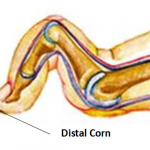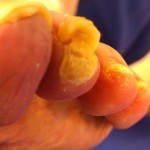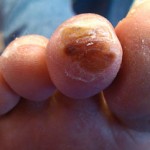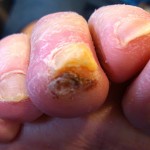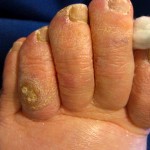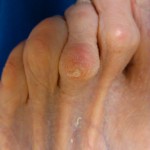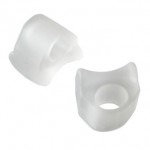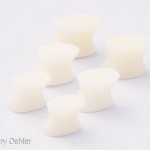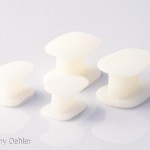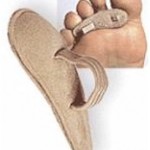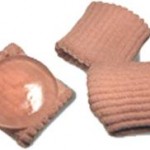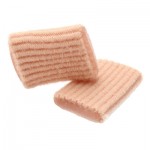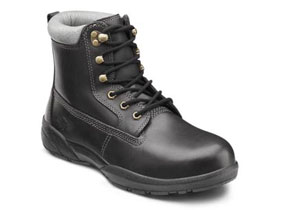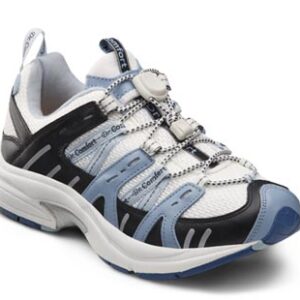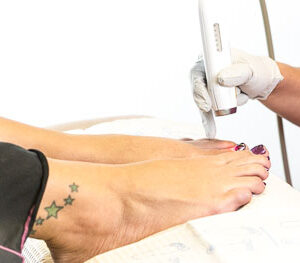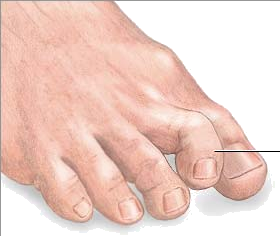
A painful toe corn is typically caused by hammertoe
Painful Toe Corn
A painful toe corn is a thickened skin deposit occurring in response to pressure. In most cases, the pressure is caused by ill-fitting shoes, hammertoes, or arthritis. A painful toe corn may or may not have black areas inside them. This can make it difficult to tell the difference between a Plantar wart and a corn. When a painful toe corn has black spots in them, they are technically called ulcers. In people with diabetes and some other disorders where the nerves do not function properly, people will not feel pain until the corn has started to cause severe build up, an open wound or even an infection. There are several different types of corns so I will break them down into groups based on treatment and location. The treatments will be broken down in to two categories conservative (non-surgical) and surgical options to make it easier to understand.
Distal Hard Corns
Corns and hammertoes go hand and hand when it comes to a painful toe corn on the tip of the toe. This type of painful toe corn is caused by excessive pressure at the tip of the toe. When the heel comes off the ground, the tip of the toe is driven into the ground, the toe responds by generating additional skin for protection. This additional skin results in more pressure, break down, and pain. These can break open, cause ulcers and/or infection. If left untreated the infection can progress in to the toe or foot and the bones resulting in amputation.
- Distal corn occurs under toe bone
- Distal corn extending under the nail
- Distal Corn with break down and blood deposition
- Distal Corn with blood deposition and nail damage
Conservative Treatment
There are only a few types of conservative treatments effective for this type of painful toe corn. The most effective conservative treatment are called crest pads. Crest pads can be constructed by your podiatrist or store bought. Sometimes I prefer the podiatrist made ones, because they are more customized to the problem and typically work better. The store bought ones often work but for short periods of time. I do not ever recommend corn “medicine”. These are compounds with a high concentration of salicylic acid designed to eat skin away these are not specific to corn tissue.
- Silicone Crest Pad
Surgical Treatment
Surgical treatment is the only way to cure these deformities permanently. The corn is a symptom of the hammertoe and the hammertoe is a symptom of an unstable foot. Because the hammertoe is a structural deformity caused by bone, ligament, and/or tendons they need to altered to regain the proper alignment of the toe. This can be done different ways and depends on your podiatrist’s preferences. Usually, the healing time is about 3-4 weeks with hammertoe surgery.
Dorsal Hard Corns
Dorsal hard corns are most commonly found on the 2nd and 5th toes, however they can occur on any toe. They occur on top of the toe at the 1st toe joint, known as the proximal interphalangeal joint (PIPJ). This painful toe corn is caused by pressure and shear force from the shoe causing irritation on the top of the toe, therefore this corn is strictly a problem between the toe and the shoe. Shoes that do not have enough height in the toe box will cause pressure across this area resulting in a painful toe corn. In some cases the hammertoe is so severe, no shoe will accommodate the deformity. 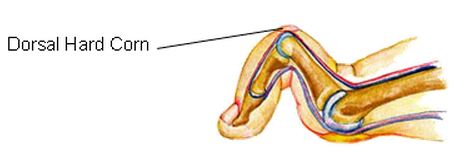
- Before Debridement (trimming) of the corn
- After debridement of the corn, notice the cores, this is where the bone communicates with the skin
- Corn on arthritic Joint
Conservative Treatment
Conservative treatment may work in less severe cases. There are a few different options that relieve the pain and cause the corn to go away. Visco gel sleeves work well if the shoe has room, it placed over the toe to absorb the sheer force occurring over the prominence. In my opinion the most effective conservative treatment is accomplished by custom molded digital devices. These devices are made by your podiatrist with a compound that when mixed hardens into a device capable of offloading the area where the corn forms. Open toed sandals without straps across the toes will alleviate the pressure and the corn will go away. In some of my patients with severe deformities an X is cut in the shoe where the pressure is located. This quickly brings relief.
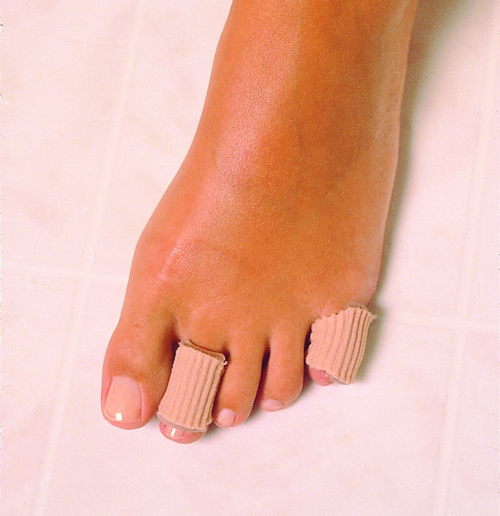
Gel corn pads
Surgical Treatment
Surgical treatment is much the same as it is for distal hard corns.
Interdigital Soft Corns
A painful toe corn between the toes or an Interdigital soft corn can occur in any of the interspaces. Usually one corn will form between the toes, however there can be a communicating corn as well. Interdigital corns can be very painful and come on quickly. Most are easy to trim by a skilled podiatrist. Interdigital soft corn are caused by bony prominences creating excessive pressure between the toes resulting in a corn. The bony prominences are usually the result of arthritic changes in the joints of the toes.

Soft corn
Conservative Treatment
Conservative treatment is pretty straight forward for Interdigital soft corns. Putting something soft between the toes to alleviate the pressure can prevent the corn from forming. There are several different types of toe separators made from foam, felt, and Visco gel that work very well, however, many people use cotton or lamb’s wool with good results. This normally is a problem between two toes, but tight shoes squeezing the toes together will cause an increase in pressure and pain. Shoes with extra room in the toe box will help. Totally Feet Podiatry and Laser Center Now offers a Toe Separator Sampler Pack for those not sure which is going to work best for them.
- Gel Toe Spacer
- Gel Toe Spreader
- Secured Toe Separator
- Silicone toe separators low profile in place
Surgical Treatment
Surgical treatment is the same as it is for the hammertoes in most cases. In years past Minimal incision surgery was performed by shaving off some of the bone responsible for the pressure. This surgery lost favor for various reasons- mainly because it didn’t work.
Foot Pads and Appliances
Crest Pads Indications: Distal corns, migrating fat pat, Hammer toes, pain on tips of toes, over lapping toes,
- Silicone Crest Pad
Silipos Gel toe Pads
Indications: Dorsal Corns, Lateral Corn, Lister Corn’s, Pressure on top of toe from shoes, hammer toes.
- Corn Pads
Silipos Gel toe separators
Indications: Interdigital Corns, overlapping toes, painful toes, bunions, tailor’s bunions, pressure between toes.
- Silicone toe separators low profile in place

